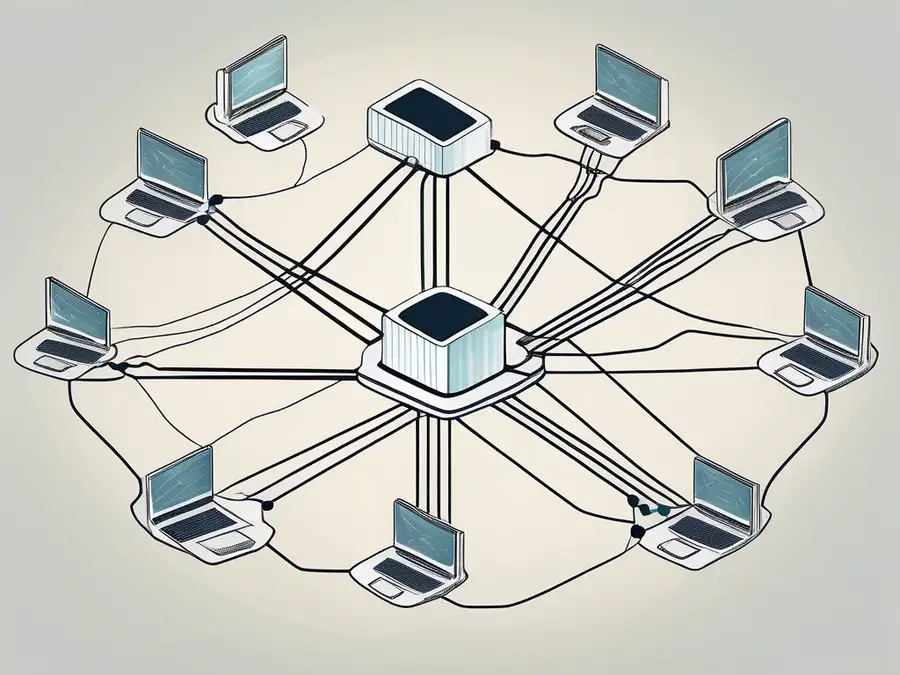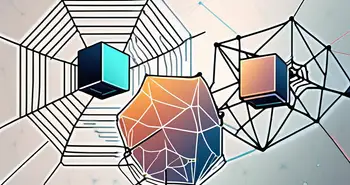Everything You Need to Know About P2P Networks

In this guide, we will explore the definition of P2P network technology, its evolution, architecture, types, advantages, and challenges. By the end of this article, you will have a comprehensive understanding of P2P networks and how they have transformed the digital landscape.
Understanding P2P Network Technology
Let's begin by defining what exactly P2P network technology is and how it works. P2P stands for Peer-to-Peer, and it refers to a decentralized network architecture where participants, or peers, communicate and share resources directly with each other without the need for a central server. Unlike traditional client-server networks, where one central server manages all communications and resources, P2P networks distribute the workload among the participating nodes.
This distributed nature of P2P networks offers several advantages, such as increased scalability, fault tolerance, and cost efficiency. Moreover, P2P networks have evolved significantly since their inception, revolutionizing the way we share files, access content, and collaborate online.
P2P network technology is a decentralized network architecture where participants, or peers, communicate and share resources directly with each other, without the need for a central server.
The Evolution of P2P Network Technology
P2P networks have come a long way since their humble beginnings. They first gained popularity with the rise of file-sharing applications, such as Napster, in the late 1990s. These early P2P networks enabled users to share and download music files directly from each other's computers, bypassing traditional means of file distribution.
Over time, P2P networks have evolved to support a wide range of applications, from content distribution and streaming to communication and collaboration. Today, P2P technology is at the heart of popular platforms like BitTorrent, Skype, and blockchain networks.
For example, BitTorrent, launched in 2001, revolutionized file sharing by allowing users to distribute large amounts of data efficiently. More recently, blockchain technology, which underpins cryptocurrencies like Bitcoin, uses P2P networks to ensure decentralized and secure transaction processing.
The Architecture of P2P Networks
Now that we have a basic understanding of P2P network technology, let's delve into its architecture. P2P networks can be classified into two main types: unstructured and structured. Each type has its own unique characteristics and use cases.
Basic Structure of P2P Networks
In an unstructured P2P network, peers connect to each other randomly, forming a mesh-like structure. This decentralized approach allows any peer to connect with any other peer in the network, without the need for a central coordination mechanism. Unstructured P2P networks are commonly used for file-sharing and content distribution.
In a structured P2P network, on the other hand, peers are organized in a specific structure, typically a distributed hash table (DHT). This structured approach provides efficient resource lookup and retrieval, making structured P2P networks suitable for applications that require fast and reliable data access.
For instance, Ethereum, a leading blockchain platform, uses a structured P2P network with a DHT to manage and retrieve smart contracts and transaction data efficiently. This structured network ensures that data can be quickly and reliably accessed by any node in the network.
Key Components of P2P Networks
Regardless of the type, P2P networks rely on certain key components to facilitate communication and resource sharing. These components include:
Peer Nodes: These are the individual participants in the P2P network, each contributing resources and acting as both a client and a server.
Overlay Network: This is a virtual network that sits atop the physical network infrastructure and enables peers to connect and communicate with each other.
Routing Protocols: These protocols determine how data is routed through the P2P network, ensuring efficient and reliable delivery.
Indexing and Discovery Mechanisms: These mechanisms allow peers to locate and access resources available in the network.
Security Infrastructure: P2P networks employ various security measures to protect against malicious activities and ensure data integrity and confidentiality.
By understanding these key components, we can appreciate the complexity and power of P2P network technology.
Types of P2P Networks
P2P networks can be further classified into two main types: unstructured and structured. Let's explore each type in more detail.
Unstructured P2P Networks
In an unstructured P2P network, peers connect to each other randomly, forming a mesh-like structure. This decentralized approach allows any peer to connect with any other peer in the network, without the need for a central coordination mechanism.
Unstructured P2P networks are commonly used for file-sharing and content distribution. For example, platforms like BitTorrent utilize unstructured P2P networks to facilitate the sharing of large files among peers across the globe. This decentralized approach not only reduces the burden on individual servers but also enables faster and more efficient file transfers.
Structured P2P Networks
In a structured P2P network, peers are organized in a specific structure, typically a distributed hash table (DHT). This structured approach provides efficient resource lookup and retrieval, making structured P2P networks suitable for applications that require fast and reliable data access.
Structured P2P networks are commonly used for distributed data storage and retrieval. For example, blockchain networks like Ethereum use a structured P2P network to store and validate transactions across multiple nodes. This decentralized and tamper-resistant approach ensures the integrity and security of the blockchain.
The Advantages of P2P Network Technology
Now that we have explored the architecture and types of P2P networks, let's delve into the advantages they offer over traditional client-server networks.
Cost Efficiency and Scalability
One of the key advantages of P2P network technology is its cost efficiency and scalability. Since P2P networks distribute the workload among participating nodes, there is no need for costly centralized infrastructure. This decentralized approach not only reduces operational costs but also enables networks to easily scale to accommodate increasing demand.
For example, streaming platforms like Spotify leverage P2P networks to deliver their vast catalog of music to millions of users worldwide. By utilizing the computing resources of their users, these platforms significantly reduce their infrastructure costs while providing seamless and uninterrupted streaming experiences.
Robustness and Fault Tolerance
P2P networks exhibit robustness and fault tolerance due to their decentralized nature. Unlike client-server networks, where the failure of a central server can disrupt the entire network, P2P networks can continue to function even if individual nodes fail or leave the network.
For instance, in a file-sharing P2P network, if one peer becomes unavailable, other peers can still access the shared file from alternative sources. This fault-tolerant behavior ensures that P2P networks remain resilient and available, even in the face of failures or network disruptions.
During the 2020 COVID-19 pandemic, the demand for video conferencing surged. Platforms like Skype, which utilize P2P technology, demonstrated the robustness of P2P networks by maintaining reliable communication channels despite increased user activity.
The Challenges of P2P Network Technology
While P2P network technology offers numerous advantages, it also presents certain challenges that need to be addressed.
Security Concerns in P2P Networks
One of the main challenges in P2P networks is ensuring security and protecting against malicious activities. Due to the decentralized nature of P2P networks, it becomes more difficult to enforce security measures and regulate access to resources.
For example, in a file-sharing P2P network, there is a risk of unauthorized access to copyrighted content or the spread of malware. To mitigate these security concerns, various techniques such as encryption, digital rights management, and reputation systems are employed.
Recent developments in blockchain technology have introduced advanced security measures in P2P networks. For instance, blockchain platforms like Ethereum implement cryptographic techniques and consensus algorithms to ensure the integrity and security of transactions.
Legal and Ethical Issues
P2P networks have also raised legal and ethical concerns, particularly in the context of file-sharing and copyright infringement. While P2P technology itself is not illegal, its misuse for sharing copyrighted content without permission has led to legal battles and debates over intellectual property rights.
As an expert in P2P network technology, I advise both users and service providers to exercise caution and respect legal boundaries when utilizing P2P networks. By adhering to ethical practices and supporting legitimate content creators, we can ensure the continued development and adoption of this powerful technology.
In 2021, the music industry saw a resurgence of debates over intellectual property rights due to the increased use of P2P networks for sharing music and videos. Legal actions were taken against several platforms, highlighting the importance of ethical considerations in the use of P2P technology.
Conclusion
With this comprehensive guide, you now have a solid understanding of P2P network technology. Whether you are a technology enthusiast, a content creator, or a business owner, this knowledge will empower you to leverage the benefits of P2P networks and navigate their challenges effectively.
Remember, as an expert, my personal advice is to embrace the possibilities offered by P2P networks while being mindful of their implications. By staying informed, adopting best practices, and contributing positively to the P2P community, we can shape a future where decentralized technologies propel us towards a more connected and collaborative world.
FAQ
What is P2P network technology?
P2P network technology is a decentralized network architecture where participants, or peers, communicate and share resources directly with each other, without the need for a central server.
How do P2P networks work?
In a P2P network, peers connect and communicate with each other directly, sharing resources such as files, bandwidth, or computing power. This decentralized approach offers advantages in terms of cost efficiency, scalability, and fault tolerance.
What are the types of P2P networks?
P2P networks can be categorized into two main types: unstructured and structured. Unstructured P2P networks allow any peer to connect with any other peer randomly, while structured P2P networks organize peers in a specific structure, typically a distributed hash table (DHT).
What are the advantages of using P2P network technology?
P2P network technology offers several advantages, including cost efficiency, scalability, and fault tolerance. By distributing the workload among participating nodes, P2P networks reduce infrastructure costs, enable easy scalability, and remain resilient even in the face of failures or disruptions.
What are the challenges of using P2P network technology?
P2P network technology presents challenges related to security and legality. Ensuring the security of resources and protecting against malicious activities becomes more challenging in decentralized networks. Additionally, issues related to copyright infringement and intellectual property rights have been associated with P2P networks, requiring careful consideration and ethical use.
With this comprehensive guide, you now have a solid understanding of P2P network technology. Whether you are a technology enthusiast, a content creator, or a business owner, this knowledge will empower you to leverage the benefits of P2P networks and navigate their challenges effectively.
Remember, as an expert, my personal advice is to embrace the possibilities offered by P2P networks while being mindful of their implications. By staying informed, adopting best practices, and contributing positively to the P2P community, we can shape a future where decentralized technologies propel us towards a more connected and collaborative world.
Embrace the future of decentralized technology with Morpher, the revolutionary trading platform that leverages blockchain to redefine investing. With Morpher, you can trade a diverse range of assets from stocks to sneakers, all with zero fees, infinite liquidity, and the safety of a non-custodial wallet. Whether you're looking to start with fractional investing, take advantage of 10x leverage, or explore unique markets, Morpher offers a seamless and innovative trading experience. Ready to transform the way you trade? Sign Up and Get Your Free Sign Up Bonus today and join the global community of traders on Morpher.

Disclaimer: All investments involve risk, and the past performance of a security, industry, sector, market, financial product, trading strategy, or individual’s trading does not guarantee future results or returns. Investors are fully responsible for any investment decisions they make. Such decisions should be based solely on an evaluation of their financial circumstances, investment objectives, risk tolerance, and liquidity needs. This post does not constitute investment advice.

Painless trading for everyone
Hundreds of markets all in one place - Apple, Bitcoin, Gold, Watches, NFTs, Sneakers and so much more.

Painless trading for everyone
Hundreds of markets all in one place - Apple, Bitcoin, Gold, Watches, NFTs, Sneakers and so much more.








